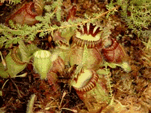

Plant Care
Here are a few points to help you grow your
carnivorous plants:
Most of these plants like wet growing conditions
(boggy), so stand the plant pots in a tray of water when they are
growing. 1 to 5 cm depth of rainwater is best, or use distilled water
or soft tap water. Hard water is not good as the mineral salts build up
in the soil and rot the roots.
Never use plant fertilizers on the plants as they are used to growing
in nitrogen deficient bogs and obtain all the nutrients they require
from the insects they catch. Do not feed the plants pieces of meat as
this
may rot the leaves. You can feed them with live insects if they are
indoors or in a terrarium where they cannot catch insects.
The plants are grown in a mixture of sphagnum moss peat and washed
perlite or silver sand. Check that the peat has no added fertilizer, it
should
be acidic. Repot or divide your plants in the spring before new growth
starts.
Most of the plants like full sun to bring out their best colouration,
flowers and vigorous growth. Provide some shade from hot direct sun in
the summer for Nepenthes, Darlingtonia, Cephalotus,
Drosera regia and Pingicula.
During the winter some of the plants such as the Venus flytrap, Sarracenia,
and hardy Pingicula and Drosera, go into dormancy to
rest during the cold weather (5-10 degrees C). During this time give
the plants only enough water to keep the compost damp, not wet, to
avoid rotting
or mould. These plants need dormancy to induce flowering in the spring
and can be grown outside.
Remove dead or brown foliage to stop any mould
taking hold. Aphids can be a problem in the spring on new growth, but
they can be removed by hand or with a paintbrush dipped in the sticky
mucilage from the sundews, or they can be sprayed with soapy water.
The Plants:
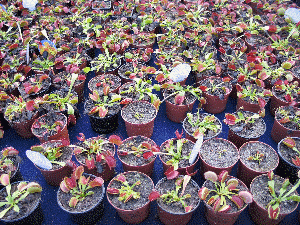 The Venus flytrap |
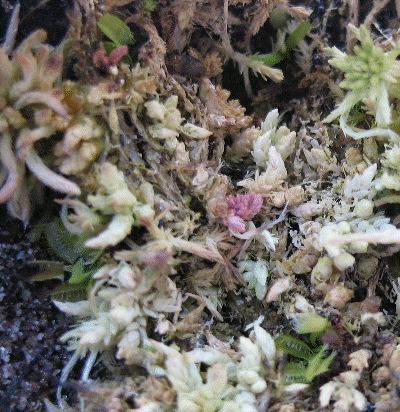 VFT seedlings at 1 year |
The Venus flytrap, Dionaea muscipula
The Venus flytrap (Dionaea muscipula) grows in bogs in North and South Carolina in the United States. It enjoys full sun which brings out the strong red colours of the traps. In the summer it loves a southfacing windowsill, and prefers standing in 2-5 cm of rain water. But in the winter it must be kept cool, e.g. in a greenhouse, cold frame or on a cold northfacing windowsill. The plant then undergoes a rest period and the traps may die away. The plant must be kept damp, but not wet otherwise it will rot, therefore do not stand permanently in water in winter. As the plant gets warm in spring new traps will be produced and watering can be increased. If the winters are not too severe the venus flytrap can be kept outdoors all year round in an open sunny spot.
The venus flytrap catches flies by the rapid action of its traps. On the suface of the trap sit nectar glands which attracts insects along with the strong colours. There are 3 trigger hairs on each side of the trap. If one of the hairs is touched twice within 20 seconds or two of the hairs are touched the trap slams shut in a fraction of a second. The struggles of the caught insect stimulate the trap further and then digestive juices are released dissolving the insides of the insect. The insect is flattened as the back surface of the trap grows to seal the edges of the trap together and form a 'stomach' to absorb the digested juices. After 4 to 10 days the trap opens and the dried out insect husk is washed away by rain.
It is not a good idea to trigger the traps with your finger as that costs the plant a lot of energy, with no benefit of a meal for the trap to recover. A trap will only open and close about six times before dying. Feeding the traps with live insects is possible, but do not use pieces of meat as this will rot the traps. In winter when the plant is cold or the traps are old, much more stimulation will be needed to close a trap and the trap will be sluggish or slow.
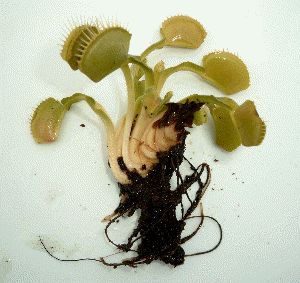 In the spring or summer when the plant is
mature it will produce a flower shoot from the centre of the leaves.
Cut this off unless you want to collect seed as it takes energy from
the plant. As the plant gets older it will become multi-crowned from
division of the base of the plant. If the plant is removed from the
soil each 'bulb' or group of leaves and traps can be divided (if they
each have well developed roots) to produce separate plants in early
spring. Repot in a mixture of 3 parts spagnum moss
peat to 1 part silver sand (washed).
In the spring or summer when the plant is
mature it will produce a flower shoot from the centre of the leaves.
Cut this off unless you want to collect seed as it takes energy from
the plant. As the plant gets older it will become multi-crowned from
division of the base of the plant. If the plant is removed from the
soil each 'bulb' or group of leaves and traps can be divided (if they
each have well developed roots) to produce separate plants in early
spring. Repot in a mixture of 3 parts spagnum moss
peat to 1 part silver sand (washed).
Sarracenia
The genus Sarracenia is a group of species found
mostly in the southeastern corner of the USA. Most are erect, trumpet
shaped plants, but a few species are much shorter. Sarracenia have
passive traps, that means they have no rapidly moving parts and the
lids do not shut! They capture insects by attracting them with nectar.
The slippery sides of the pitcher and downward pointing hairs stop the
insects escaping from their pitchers once the prey topple in. Some
species exude an amazing variety of chemicals, including digestive
enzymes, wetting agents, and insect narcotics! Others rely on bacterial
action to d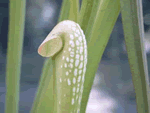 igest the prey.
igest the prey.
The usually recognized species are listed below.
S. alata (Pale pitcher plant)
S. flava (Yellow pitcher plant) (see below)
S. leucophylla (White-topped pitcher plant)
S. minor (Hooded pitcher plant, see illustration → )
S. oreophila (Green pitcher plant)
S. psittacina (Parrot pitcher plant)
S. purpurea ssp. purpurea (Purple pitcher plant or
Northern Huntsmans Cap)
S. purpurea ssp. venosa (Southern Huntsmans Cap) (also venosa
var. burkii and var. montana)
S. rubra ssp. alabamensis (Canebrake pitcher plant)
S. rubra ssp. gulfensis
S. rubra ssp. jonesii (Mountain pitcher plant)
S. rubra ssp. rubra (Sweet pitcher plant)
S. rubra ssp. wherryi
Sarracenia is a very easy genus of carnivorous plants to grow. As a
planting medium, I use a 4:2:1 ratio of peat:perlite:sand. It is kept
wet year round, lots of water in the summer and only just damp
in the winter. 50:50 sand:peat or Sphagnum can also be used. Repot the
plants during the spring or summer, when they have outgrown their pot.
Sarracenia require bright full sun as they would receive in Florida. This means that they are not suited for terrarium culture, except as seedlings, as the light will only reach the top of the pitcher. If your erect trumpet pitcher plants are all floppy and keep toppling, they are not getting enough light. The pitchers should be able to support their own weight.
Sarracenia expect a spring, summer, fall, and
winter. During the spring, they flower. During the summer, they produce
a crop of pitchers early in the season (S. leucophylla makes a second
crop). During the fall, they just sit there (some species make
modified, nontrapping leaves during this season). During the winter,
the remains of the summer leaves slowly die back and the dead parts can
be cut off to avoid rot.
All the species are endangered because of widescale habitat
destruction. This is the single major foe to the genus. The rarest
species are well protected from habitat destruction, but they are still
under a great deal of collection pressure by horticulturists. Field
collection (poaching!) of rare forms by collectors has wiped out some
stands of plants. Recently, pitcher collection for the floral
arrangement
industry is posing new problems. The floral trade will probably push S.
leucophylla closer to extinction because of that species
beautiful pitchers.
Sarracenia flava varieties
This species is a grand, erect pitcher plant with some of the largest pitchers of the Sarracenia. In the wild, this plant is found along the southeastern coastal plain of the USA, from Alabama up to a few sites in Virginia. It is most threatened by habitat destruction. This species has been divided into seven varieties. These varieties are distinguished mostly by pitcher pigmentation. They are as follows:
the entire pitcher tube and lid are a deep red.
Sarracenia flava var. cuprea
a reddish or copper tinted lid, contrasting with a green pitcher tube.
Sarracenia flava var. flava
a red throat patch, with little or no veining on the pitchers.
Sarracenia flava var. maxima
pale green pitchers.
Sarracenia flava var. ornata
a red throat patch and intense venation is found all over the pitcher tube and lid.
Sarracenia flava var. rubricorpora
this plant has a red tube, with the lid veined and either yellow or green.
Sarracenia flava var. rugelii
a big lid, a red or purple throat patch, and no red pitcher or tube venation.
You may also find plants intermediate in characteristics resulting from crosses between the varieties.
Tropical sticky leaved
Sundews (Drosera)
The dewy drops on the ‘sun-dew’ glisten in the sun to attract insects, hence its name. When a fly is caught by the sticky drops of mucilage on the end of each tentacle, the flies struggles cause the tentacles to move and wrap around the fly. When the fly is held immobile juices are secreted to digest the fly and the insides of the fly are absorbed. The Cape Sundew has the most mobile leaves of the sundews, and when a large fly is caught, the leaf will wrap around the fly several times to help trap and eat the fly. Tropical sundews such as the Cape Sundew from S. Africa (Drosera capensis), can be grown indoors on a warm sunny windowsill. If kept warm these plants will grow year round and do not need a dormancy period. Plant them in a mixture of 3 parts peat to 1 part silver sand.
Tropical Butterworts (Pinguicula)
Tropical Butterworts such as Pinguicula moranensis from Mexico can also be grown on a warm sunny windowsill. These plants like to be kept a little drier, so grow them in an open compost with 1 part peat to 1 part sand and do not over water in the winter.
Heliamphora
Sun pitchers or Heliamphora, grow on remote and isolated table top mountains known as tepuis, in Venezuela, Guana and N. Brazil. The cliffs of the tepuis rise another 500 - 1200m above the cool tropical savannas which are already at a hight of over 1000m. The Heliamphora are often sitting inside the clouds which blanket the tepuis, interspersed with bright sunshine. The extremelly high rainfall means there is little soil or nutrients, so the Heliamphora suppliment their poor diet with insects caught in their simple pitchers. The pitchers look like rolled up leaves which have been sealed along the front, and a small nectar hood at the top to attract insects.
The high altitude means the plants like cool nights of 5 to 15
degrees and daytime temperatures of 16 to 27 degrees C. Temperatures
above 30 degrees can kill them. Give them high humidity, good air
circulation and bright light. Water from overhead daily and mist
reguarly. A terrarium is ideal. Use a
very well drained compost such as pure perliet, or perliet with a
little sphagnum
or peat mixed in. Try to avoid root distubance or division as the plants are fragile. Propagation is from seed which
is very slow, or careful division of mature plants when they have
produced large clumps.
The species:
Heliamphora heterodoxa (15 to 25 cm)
Heliamphora ionasi (largest pitchers to 7.5 cm)
Heliamphora minor (smallest to 7.5 cm)
Heliamphora neblinae (to 25 cm)
Heliamphora nutans (to 15 cm)
Heliamphora tatei (shrubby stems up to 4 m)
Nepenthes
The topical pitcher plants, Nepenthes, grow in the hot steamy
jungles in the Far East, around Borneo. They climb up into the trees
like vines, growing a pitcher on a tendril at the end of each leaf. The
King Monkey
Cup grows the largest pitchers, up to 35 cm in length by 15 cm wide,
and
accidental meals include reptiles and mammals as large as rats!
Nepenthes
like warm humid conditions and cooler nights, so grow them indoors in
bright
light, but not hot direct sun and spray them with rainwater once or
more
a day. Water from the top regularly, but do not let them stand in
water.
Grow in live sphagnum moss or a mixture of 2 parts orchid bark, 2 parts
horticultural
Perlite and 1 part peat. They can be grown nicely in a hanging basket
to
allow the pitchers to hang down and the vines to trail. Nepenthes grow
very
well in a terrarium with artificial lighting above, as do other
tropical
carnivorous plants.
See also Nepenthes Species and Hybrids
Cephalotus follicularis
The Western Australian Pitcher plant, Cephalotus
follicularis is rare in nature, and only grows in some bogs in the
extreme south-western tip of Australia. The plant consists of small
slipper shaped pitchers sitting on the ground, upto 5 cm long, and
flat, green, paddle
shaped leaves.
I grow mine in a seed tray with a clear plastic propagator lid over the top and a compost of 3 parts turf to 1 part silver or play sand (you can use perliet instead of the sand), with live spagnum over the top. Some people grow it without a cover, but it is one plant that will do well in a propagator. Cephalotus likes lots of room for its roots to spread. I put my cephalotus under the benching in my frost free greenhouse in shade, and it has grown well (for 18 years) but slowly with a good red colour. It sits in a tray of water in the summer and is just kept damp in the winter (min. 4 degrees). It also grows well in the polytunnel on the staging in the propagator with only shade from the other plants. It can also be grown on the windowsill indoors. The easiest method of propagation is by division of the plant when it has grown into 2 or more clumps. Leaf or root cuttings can also be made. Seed is difficult to produce and takes a long time to grow a mature plant.
Some Cephalotus you buy can have a problem with fungus in the roots and they grow poorly or die (treat with a fungicide). If you over water them in winter that can rot them, or if you put them in direct hot sun in the summer they can get burnt and die quite quickly.
Other
Compost = 2 parts sand : 1 part turf (well drained compost)
temperature 18 - 30 degrees C
location: bright terrarium or sunny greenhouse (heated in winter)
stand in a tray of water (if it drys out the plant will go into dormancy as in the wild during the dry season)
Drosera prolifera, from humid, shaded tropical rainforest in Queensland, Australia
Compost = long fibered spagnum, which means it needs an aerated (lots of air in it and free draining but humid/wet) compost to grow in.
temperature 12 - 26 degrees C with high humidity
location: terrarium or north facing windowsill under a propagator (not direct sun)
stand in a tray of water
